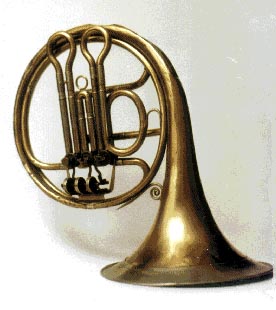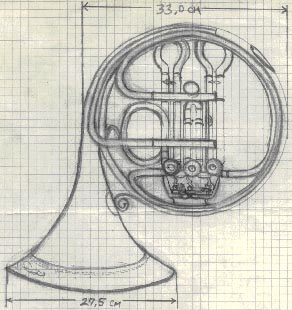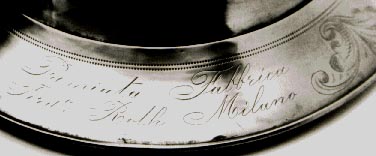
|
| The label on the garland reads "Premiata Fabbrica / Ferdo. Roth Milano."
Roth was born in Adorf, Germany in 1815 and died in Milan, Italy in 1898.
He worked first for Pelitti, and later as a foreman in Prague and Vienna.
The establishement of his Premiata Fabbrica in Milan is given variously
as 1838, and 1842. Roth instruments were exhibited in Florence (1861),
Santiago (1875), Milan (1881, 45 brass instruments, and 1894).
An 1878 city directory lists the address at vis S. Giovanni in Conca 9,
Milano. In 1892 a one-page catalogue was issued, "Premiata fabbrica d'instrumenti
musicali in ottone e legno Ferdinando Roth." In 1894 he advertised
as a specialist in saxophones and claimed to be the original supplier of
Aida trumpets made according to Verdi's instructions. In 1894, blind
and in his eighties, he put his son-in-law, Antonio Bottali, in charge
and on his death in 1898 the firm became Roth & Bottali.
The late Rev. Dr. Wilhelm Bernoulli estimated that this horn was made
circa 1875. Dr. Bernoulli cited that Prof. Karl Burri, of Berne,
has a similar instrument made in Milan and that Prof. Burri also had seen
the horn players of the Carabinieri Band pointing their instruments in
the air. Dr. Bernoulli also suggest that it might have been designed
for cavalry.
Prof. Kurt Janetzky agreed with the 1875 estimate and stated that right
handed horns such as this were not uncommon. He also agreed that
it was probably designed for cavalry use since it would be impossible for
mounted troops to use their hands in the bell. In their book, Das
Horn (p.66), Profs. Janetzky and Bruchle state that it was A.F. Sattler
(Leipzig, 1819) who moved the valves to the left hand which made
it possible again to use the right hand for stopping and other hand horn
technique. That is to say that the first valved horns by Stoetzel
had the valves placed on the right, the same side as the bell. This
also indicates that from the beginning the valved horn was considered (at
least by its inventos) as a fully chromatic instrument. Hence the
valves were not intended to be a method for changing tuning crooks.
|
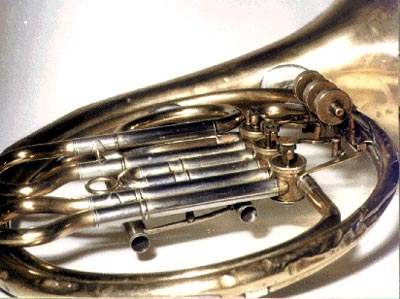
|
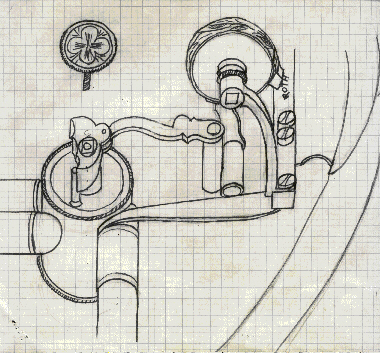
|
| This drawing shows the detail of the valves. The retaining screw
is shown removed from the end of the rotor. The tapered valve cores are
removed from casing at the linkage end (top in this drawing). A threaded
ring on the top of the casing holds the plate with the bumper post
and bearing. Most modern rotary valves are removed from the end opposite
from the valve linkage. The valve parts are labelled "30".
|
|
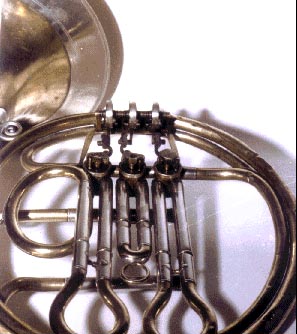
|
|
|
References
Pfr. Dr. h.c. Wilhelm Bernoulli, private correspondance October 18,
1978
Profs. Kurt Janetzky and Bernhard Bruchle, Das Horn,Hallwag Verlag,
Bern and Stuttgart, 1977
Prof. Kurt Janetzky, private correspondance, July 16, 1987
Lyndsay G. Langwill, An Index of Musical Wind Instrument Makers,
5th ed., 1977
William Waterhouse, The New Langwill Index of Wind Instrument Makers
and Inventors, pub.Tony Bingham, London 1993 |
|
|
Two other right handed horns
are shown below:
|
|
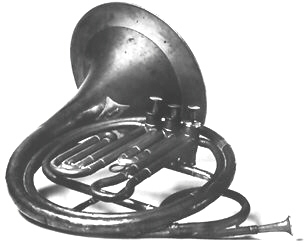
|
| Right handed horn with three piston valves, presumably a reconstruction
of an Inventionshorn. Not inscribed Key: G, with F (and C)
crook Kulturgeschichte Des Horns, K. Janetzky and B. Bruchle, Hans
Schreider, Tutzing, 1976, p. 262 Note. the valves are Berlin pumpen
valves. |
|
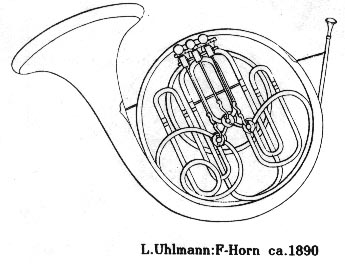
|
| Prof. Hans Pizka, Hornisten-Lexikon (Dictionary for Hornists),
Hans Pizka Edition, 1986, p. 57 |
